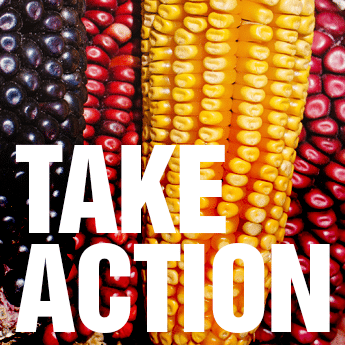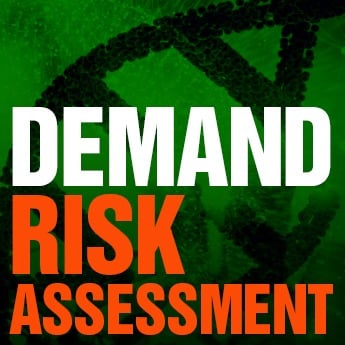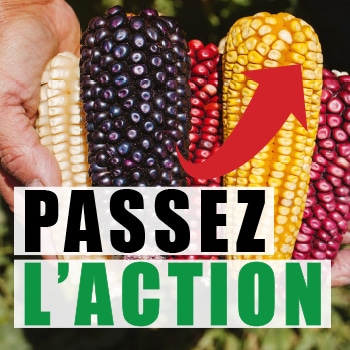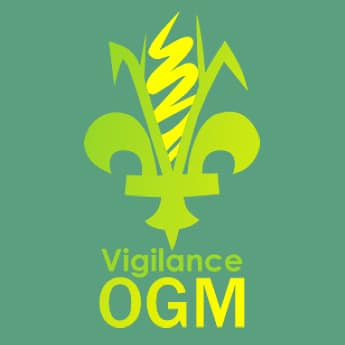Labelling
There is no mandatory labeling of genetically engineered foods in Canada despite intensive public campaigning and 20 years of polling that consistently show over 80% of Canadians want these labels.
Update – December 2018: The U.S. government has just published its “National Bioengineered Food Disclosure Standard” which will label some, but not all, genetically engineered foods.
- December 21, 2018 – Press Release: Groups Urge Canada to Reject New U.S. Example of GM Food Labelling
Take Action
- Click here to send an instant letter to the Minister of Health
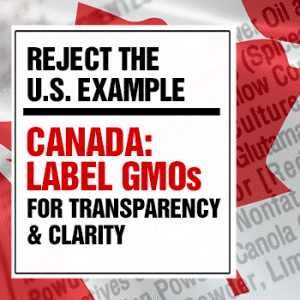
- Share this page with your friends and family
- Call your MP’s office and leave a message, or talk directly to your MP. You can find all contact details by using your postal code at www.parl.gc.ca
- Print up this petition and get it signed by 25 people in your community. Send it directly to your MP and ask your MP to present it in the House of Commons, and to let you know when they do.
- Ask for a meeting with your MP. Get a few friends together and prepare to present your case.
Click here for some responses to arguments against GM food labelling.
Background
There is no mandatory labeling of genetically modified (GM or engineered) foods in Canada despite intensive public campaigning and 20 years of polling that consistently show over 80% of Canadians want these labels.
Instead, a national standard for voluntary labeling was established – but this is voluntary and, to our knowledge, no company has yet labeled their products as containing GM ingredients. 64 countries around the world have some type of mandatory labeling GM food law including the European Union, Japan, Australia, Brazil, Russia and China. 
- An Ipsos Reid poll commissioned by CBAN in September 2015 found that 88% of consumers in Canada want labelling.
- Click here for the list of labelling polls in Canada since 1994.
- Click here for the interactive map of labelling laws across the world provided by the Center for Food Safety in the US.
- Click here for the list of countries that have mandatory labelling laws – please see the above link for details (not all the laws are comprehensive)
- The cost of GM labelling to consumers should be less than a penny a day – $2.30 per person annually, says research commissioned by the US Consumers Union.
- See CBAN’s GMO Inquiry report “Are GM Foods Better for Consumers?” for some history on why there is no labelling in Canada.
More Information
- Labelling Genetically Modified Foods. CBAN Briefing. May 2017.
- Responses to arguments against GM food labelling.
- Click here for the interactive map of labelling laws across the world provided by the Center for Food Safety in the US.
- Click here for the list of countries that have mandatory labelling laws – please see the above link for details (not all the laws are comprehensive)
- A list of labelling polls in Canada since 1994.
- October 2014: The cost of GM labelling to consumers should be less than a penny a day – $2.30 per person annually, says research commissioned by the US Consumers Union.
Labelling in Canada
Groups in Canada worked hard for many years to get mandatory labelling but could not succeed when confronted by the tremendous political and economic power of the biotech industry, as recently seen in the U.S.. In 2001, a bill for mandatory labelling was defeated (126 to 91) in the House of Commons after an intense grassroots campaign.
December 21, 2018 – Press Release: Groups Urge Canada to Reject New U.S. Example of GM Food Labelling
Press Release, May 17, 2017: Groups Call on Grocery Stores to Reject GM Fish and Produce as Parliament Votes Down Mandatory Labelling for GM Foods
- 8 polls between 1994 and 2001 confirmed that over 80% of Canadians wanted labelling.
- Watch The National report on the failure of the Private Members Bill to label GM foods in Canada, October 17, 2001.
- Read CBAN’s GMO Inquiry report “Are GM Foods Better for Consumers?” to read about why we don’t have mandatory labelling in Canada.
- You can also see the archives of federal government public relations materials.
The Canadian government’s only response to the overwhelming public call for mandatory labelling, aside from consumer “education” initiatives, was to strike a committee to create a national standard for voluntary labelling. In September 1999, the Canadian General Standards Board formed a Committee on Voluntary Labelling of Foods Obtained Through Biotechnology (which promptly changed its name to the Committee on Voluntary Labelling for Foods Obtained or Not Obtained through Genetic Engineering and then to switched terminology again to Genetic Modification). The committee was an initiative of the Canadian Council of Grocery Distributors – a national organization representing about 80% of grocery and supermarket companies in Canada.
2008: Private Members Bill defeated: A Private Members Bill to label genetically engineered foods (C-517) introduced by Gilles-A. Perron of Bloc Québécois was defeated in the House of Commons in April 2008.
- Click here to listen to the April 2008 House of Commons debate courtesy of Deconstructing Dinner.
- Click here to read the transcript of the debate
- Press Release – April 3 2008: Bill to Label Genetically Engineered Foods: Will MPs vote for Monsanto or Canadians?
- TV report on the defeat of the bill for mandatory labelling in the House of Commons, The National, October 17, 2001.
Bill C-291 – Vote Results
Private Member’s Bill C-291 for mandatory labelling of genetically modified food was voted down in the House of Commons on May 17 – 67 to 216.
Thank you for your action!
Vote Details: 67 MPs voted for the Bill – 261 voted against. Click here to find out how your MP voted.
Take Action: Consider writing to your MP – you can search for your MP’s contacts using your postal code at www.parl.ca
The bill would have established mandatory labelling of genetically modified (GM) foods. Bill C-291 was an “An Act to amend the Food and Drugs Act (genetically modified food)” and simply states “No person shall sell any food that is genetically modified unless its label contains the information prescribed under paragraph 30(1)(b.2).” It was sponsored by MP Pierre-Luc Dusseault (Sherbrooke, Quebec).
Why don’t we have mandatory labelling for GM foods in Canada?
- Click here to read some arguments against labelling from the Parliamentary debate on March 10.
- See CBAN’s GMO Inquiry report “Are GM Foods Better for Consumers?” for some history on this issue.
Press Release, May 17, 2017: Groups Call on Grocery Stores to Reject GM Fish and Produce as Parliament Votes Down Mandatory Labelling for GM Foods
Labelling in the US
US Disclosure Law for “Bioengineered” Foods = “Non-labelling GMO labelling”
December 21, 2018 – Press Release: Groups Urge Canada to Reject New U.S. Example of GM Food Labelling
The U.S. government has published its rules for mandatory disclosure of some “bioengineered” foods. Canadian public interest and environmental groups are expressing concerns about inadequate and confusing new US government rules to label some genetically modified (GM, genetically engineered) foods, and are calling on the federal government to reject this new US example and adopt full, transparent mandatory labelling instead.
In 2016, the US government passed a mandatory disclosure law for GM foods, called the “National Bioengineered Food Disclosure Standard.” This law preempted state GM food labeling laws, such as Vermont’s law to label “genetically engineered” foods that was already being implemented.
The law sets a bad precedent for transparency and consumer choice. The U.S. “disclosure” standard has many critical gaps and problems and should not be used as a model for labelling in Canada. The new U.S. standard:
- Uses the unfamiliar and poorly defined term “bioengineered” instead of the commonly used and understood term “genetically modified” (“GM”) or “genetically engineered” (“GE”);
- Does not label foods if the modified genetic material cannot be detected, therefore excluding highly processed foods such as sugar from GM sugar beet and oils from GM corn and GM canola;
- Does not require on-package text labels but instead allows companies to opt for an electronic or digital link accompanied by a telephone number “for more food information”;
- Provides the option of using a specific graphic symbol that incorporates the word “bioengineered”, with an image that is not neutral but is suggestive of a bucolic country scene;
- Has a high threshold to require disclosure only when there is more than 5% GM content versus the 0.9% threshold used in the European Union, for example.
In May 2018, the US Department of Agriculture released options for the disclosure law for public comment.June 29, 2018: Click here to read CBAN’s comments to the USDA on the disclosure options.
July 29 2016: As expected, President Obama passed the so-called “DARK Act” (“Denying Americans the Right to Know”) after it had already passed through Congress two weeks earlier. The Act is being called a “compromise” by the industry and a betrayal by the groups that lobbied for GM food labelling. The new legislation is being described by the US food movement as “non-labelling GMO labelling” because instead of requiring companies to put text such as “Produced with genetic engineering” etc. on labels (as was required in the new Vermont law), it allows companies to put digital (QR) codes on packages for reading via smartphones instead. The bill preempts Vermont’s labelling law (companies no longer need to comply with Vermont’s law) that was implemented as of July 1 and stops other US states from instituting their own mandatory labelling laws. The bill will be not be implemented for at least two years while negotiations proceed.
Vermont’s had already implemented (July 2016) their law to require packages of processed food to declare as “partially produced with genetic engineering”; “may be produced with genetic engineering”; or “produced with genetic engineering” (individual ingredients will not be identified as GM on packages). Major food manufacturers were beginning to label some foods to comply with the Vermont law:
- Mars said: “In 2014, the state of Vermont passed a mandatory genetically modified (GM) ingredient labeling law that requires most human food products containing GM ingredients to include on-pack labeling as of July 2016. To comply with that law, Mars is introducing clear, on-pack labeling on our products that contain GM ingredients nationwide….We firmly believe GM ingredients are safe.” (March 22, 2016)
- General Mills added a search tool on their website to provide GMO ingredient information for hundreds of U.S. products.(March 20, 2016)
In 2013, an initiative to label GE food in Washington state failed in a popular vote 51/49, after the food industry spent over $20 million to defeat it. In 2012, Californians narrowly voted against labelling in a California Ballot Initiative (Proposition 37) after corporations spent a total of $46 million in advertising. Get an update on US labeling campaigns here.
Labelling Around the World
64 countries around the world have some type of mandatory labeling GM food law including the European Union, Japan, Australia, Brazil, Russia and China.
- Click here for the interactive map of labelling laws across the world provided by the Center for Food Safety US
- Click here for the list of countries that have mandatory labelling laws (please see the above link for details – not all the laws are comprehensive)
Global Right to Label GM Foods Secured
After a twenty year struggle inside the global food safety body Codex, the right of countries to enact GM food labelling without threat of trade challenge was established in 2011. Thanks to your action and years of work with many groups around the world, there are international guidelines on GM labeling.
National labelling of GM foods is now protected from trade challenge. More than 100 countries agreed on long overdue guidance on the labeling of genetically modified (GM) food.
The Codex Alimentarius Commission of the UN which is made up of the representatives of government food safety regulatory agencies from around the world, worked for two decades to come up with consensus guidance on GM food labelling. In 2011, in a striking reversal of their previous position during the annual Codex summit in Geneva, the US delegation dropped its opposition to the GM labelling guidance document, allowing it to move forward and become an official Codex text. The new Codex agreement means that any country wishing to adopt GM food labelling will no longer face the threat of a legal challenge from the World Trade Organization (WTO).
National measures based on Codex guidance or standards cannot be challenged as a barrier to trade. This will have immediate implications for consumers. Click here for analysis from Consumers International.
The United Nation’s Codex guidelines on GM food labelling are voluntary and so the guidelines themselves do not compel countries to label (so this will not result in labelling in Canada for example).
- April 30, 2010 – Press Release: Canada to oppose the right of countries to label GM foods? Regroupement québécois contre les OGM (RQcOGM), Canadian Biotechnology Action Network (CBAN)
- CBAN’s letter to the Minister of Health
- May 5, 2009 – Press Release: Canada Must Support UN Negotiations on Labeling of Genetically Modified Foods: Codex meeting in Calgary could suspend work on GM food labeling. Update: Despite US and Canadian objections, the Codex meeting agreed to continue their work to develop guidelines for labeling GM foods.
Codex Alimentarius means “food code”. The Codex Alimentarius Comission is a UN process established in the 1960s by the United Nationals Food and Agriculture Organization and the World Health Organization. Through Codex, national governments meet to negotiate and harmonize guidelines for food safety assessments and other standards including food labeling. Codex guidelines are voluntary and non-binding but are an international reference point for countries. Codex standards are now the benchmarks against which national food measures and regulations are evaluated in the event of trade disputes brought forward by countries through the World Trade Organization. Consumer organizations are able to register to participate in Codex meetings and can also submit written comments for consideration.


